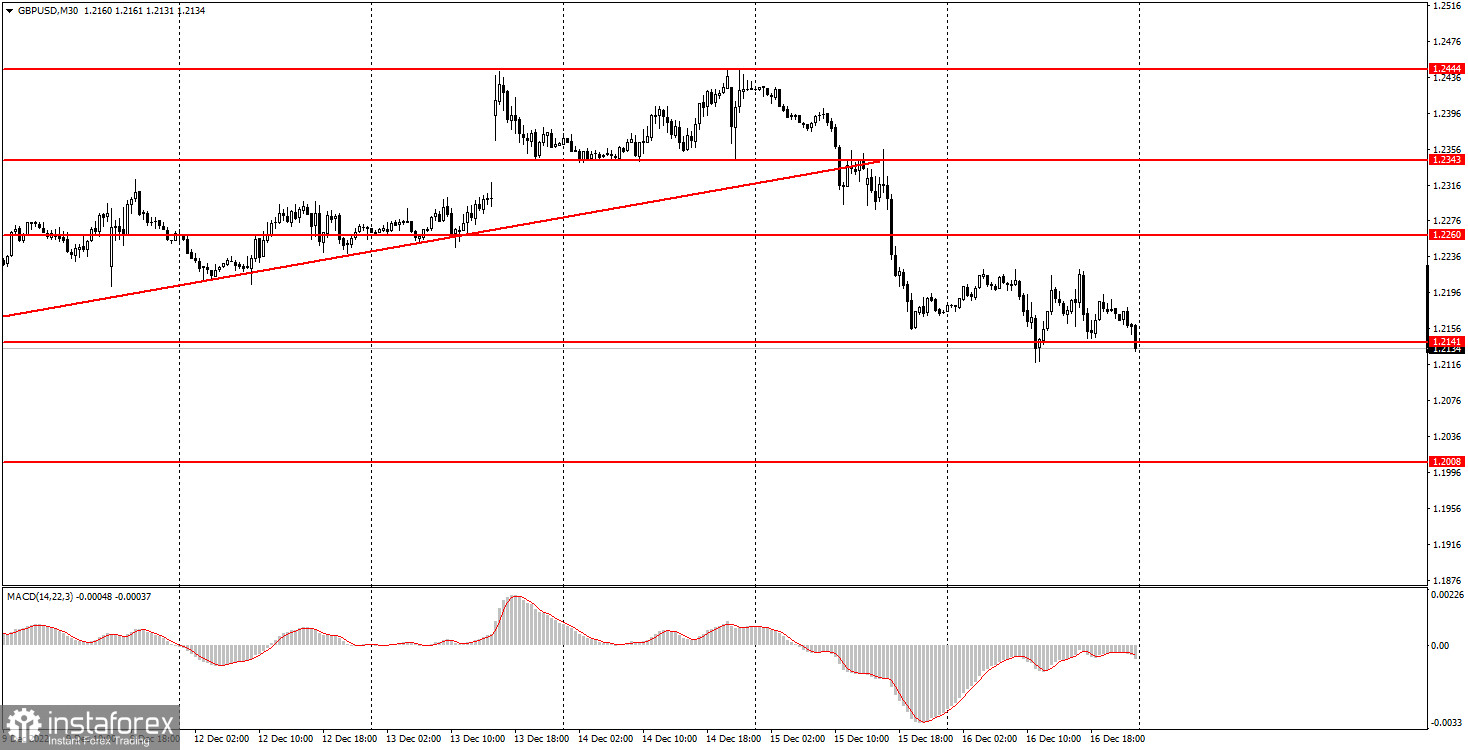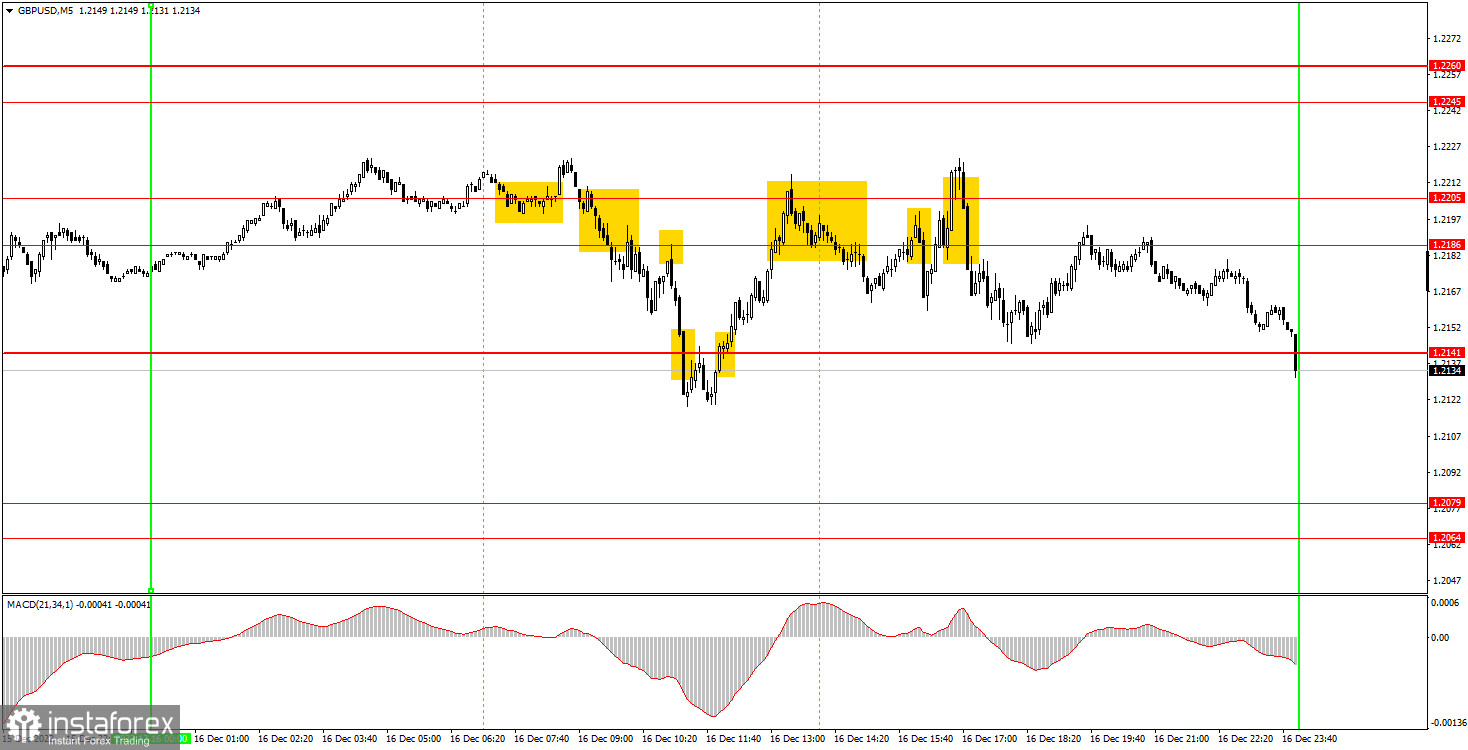Analyzing Friday trades:
GBP/USD on 30M chart

GBP/USD was trading flat on Friday. After quotes sharply fell on Thursday, it stopped moving down. I still expect to see a tangible bearish correction soon, and by and large, it has already started. Now the main thing is that it should continue, and the market doesn't start buying up the pound again without having a good reason or any grounds for it. Recall that the Bank of England and the Federal Reserve held their meetings this week. In principle, neither of the central banks made any high-profile decisions. And the pound's decline, most likely, is connected with the technical need to correct, as well as with some passivity of the BoE, which began to slow down the pace of tightening of monetary policy, having the peak inflation rate at its disposal, which has not even really started to fall. GBP has crossed the ascending trend line, so there are technical reasons on the 30-minute chart for a decline.
GBP/USD on M5 chart

There were no effective and profitable trades since the pair was flat. Basically, the chart above clearly shows the nature of the pair's movement on Friday. It should be mentioned that the manufacturing and services business activity index and a retail sales report was released in the UK. Manufacturing and service sector PMIs were published in the US. That's why we had at least three price reversal points during the day, based on macro data. Not to say that all the reports were resonant, but for instance, the US data was worse than a month before and the British retail sales were worse than the projections. However, the dollar was rising after the U.S. reports were released. That's why it is impossible to say that the market reacted in a logical manner. In general, the movements were very chaotic, but there were a lot of signals. The first buy signal near the area of 1.2186-1.2205 turned out to be false and closed with a loss. The next signal made it possible for traders to earn about 25 points. You could earn 20 more points using the buy signal near 1.2141, and the new sell signal near 1.2186 closed at Stop Loss breakeven. Therefore, beginners could even earn 10 pips on Friday, but overall the day was unfortunate.
Trading tips on Monday:
On the 30-minute time chart, GBP has a real chance of starting a downtrend as it has crossed the trend line.Of course, this week's movements were provoked by the fundamental background, and next week the market may resume its groundless purchases of the pound. But nevertheless, for the first time in a long time, we have real signals of a strong bearish correction, which we have been waiting for a long time. On the 5-minute TF tomorrow, it is recommended to trade at the levels 1.1950-1.1957, 1.2064-1.2079, 1.2141, 1.2186-1.2205, 1.2245-1.2260, 1.2337-1.2343. As soon as the price passes 20 pips in the right direction, you should set a Stop Loss to breakeven. There are no important events or reports in the UK or US on Monday. Next week can be a good time for a bearish correction.
Basic rules of the trading system:
1) The strength of the signal is determined by the time it took the signal to form (a rebound or a breakout of the level). The quicker it is formed, the stronger the signal is.
2) If two or more positions were opened near a certain level based on a false signal (which did not trigger a Take Profit or test the nearest target level), then all subsequent signals at this level should be ignored.
3) When trading flat, a pair can form multiple false signals or not form them at all. In any case, it is better to stop trading at the first sign of a flat movement.
4) Trades should be opened in the period between the start of the European session and the middle of the US trading hours when all positions must be closed manually.
5) You can trade using signals from the MACD indicator on the 30-minute time frame only amid strong volatility and a clear trend that should be confirmed by a trendline or a trend channel.
6) If two levels are located too close to each other (from 5 to 15 pips), they should be considered support and resistance levels.
On the chart:
Support and Resistance levels are the levels that serve as targets when buying or selling the pair. You can place Take Profit near these levels.
Red lines are channels or trend lines that display the current trend and show in which direction it is better to trade now.
The MACD indicator (14, 22, and 3) consists of a histogram and a signal line. When they cross, this is a signal to enter the market. It is recommended to use this indicator in combination with trend patterns (channels and trendlines).
Important announcements and economic reports that can be found on the economic calendar can seriously influence the trajectory of a currency pair. Therefore, at the time of their release, we recommend trading as carefully as possible or exiting the market in order to avoid sharp price fluctuations.
Beginners on Forex should remember that not every single trade has to be profitable. The development of a clear strategy and money management is the key to success in trading over a long period of time.
 English
English 
 Русский
Русский Bahasa Indonesia
Bahasa Indonesia Bahasa Malay
Bahasa Malay ไทย
ไทย Español
Español Deutsch
Deutsch Български
Български Français
Français Tiếng Việt
Tiếng Việt 中文
中文 বাংলা
বাংলা हिन्दी
हिन्दी Čeština
Čeština Українська
Українська Română
Română

